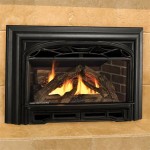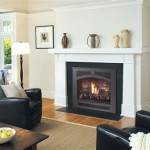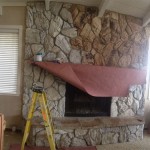Choosing the Right Mantel for Your Stone Fireplace
A fireplace serves as a focal point in many homes, providing warmth and ambiance. The mantel, when thoughtfully selected, enhances the aesthetic appeal of the fireplace and integrates it seamlessly with the room's overall design. When a stone fireplace is the base, the choice of mantel is especially important, as the textures and colors of the stone must be considered to create a harmonious and visually attractive composition.
Selecting the appropriate mantel for a stone fireplace is a multifaceted decision involving considerations of material, style, size, and installation. A well-chosen mantel complements the stone's natural characteristics, adds functionality, and contributes to the overall character of the space. Conversely, a poorly chosen mantel can detract from the fireplace's beauty and disrupt the room's design flow.
The purpose of this article is to provide a comprehensive guide to selecting the right mantel for a stone fireplace. The article will address the key factors to consider, including material options, style considerations, size and proportion guidelines, and installation techniques. By understanding these factors, homeowners can make informed decisions and choose a mantel that enhances the aesthetic value and functionality of their stone fireplace.
Material Considerations for Stone Fireplace Mantels
The material of a mantel significantly impacts its appearance, durability, and suitability for a stone fireplace. Several materials are commonly used for fireplace mantels, each with its own advantages and disadvantages. Choosing the right material involves considering the stone type of the fireplace, the overall décor of the room, and the desired aesthetic.
Wood is a popular choice for fireplace mantels due to its versatility, warmth, and natural beauty. Different types of wood offer varying grains, colors, and textures, allowing for a wide range of design options. For instance, reclaimed wood offers a rustic and weathered look, while hardwoods like oak and maple provide a more refined and traditional aesthetic. Wood mantels can be stained or painted to complement the stone's colors and the room's décor. However, it is essential to ensure adequate clearance between the wood mantel and the fireplace opening to prevent fire hazards. Wood is also susceptible to moisture damage and requires regular maintenance to prevent warping or cracking.
Stone itself can also be used as a mantel material, creating a cohesive and unified look with the existing stone fireplace. Using a contrasting type of stone for the mantel can also add visual interest. For example, a granite mantel can complement a limestone fireplace, or vice versa. Stone mantels are durable, heat-resistant, and require minimal maintenance. However, they can be heavy and require professional installation. The cost of a stone mantel can also be higher compared to other materials.
Concrete is increasingly used for fireplace mantels due to its modern aesthetic and versatility. Concrete mantels can be cast in various shapes, sizes, and textures, allowing for customized designs. They can also be stained or painted to match the stone fireplace or the room's décor. Concrete is durable, heat-resistant, and relatively low-maintenance. However, concrete mantels can be heavy and require professional installation. They can also be susceptible to cracking if not properly sealed and maintained.
Metal mantels, typically made of wrought iron or steel, offer a sleek and contemporary look. Metal mantels are durable, heat-resistant, and require minimal maintenance. They can be powder-coated in various colors to complement the stone fireplace or the room's décor. Metal mantels are often used in modern or industrial-style homes. However, metal can conduct heat, so it's essential to ensure adequate clearance between the mantel and the fireplace opening.
When selecting a mantel material, it's crucial to consider the overall design style of the room and the characteristics of the stone fireplace. The material should complement the stone's colors, textures, and patterns, creating a cohesive and visually appealing look. Consider the maintenance requirements of each material and choose one that fits your lifestyle and preferences.
Style Considerations for Complementing the Stone
The style of the mantel should complement the architectural style of the home and the design of the stone fireplace. A well-chosen mantel can enhance the fireplace's aesthetic appeal and integrate it seamlessly with the room's overall décor. Conversely, a poorly chosen mantel can detract from the fireplace's beauty and disrupt the room's design flow. Several style options are available, each with its own unique characteristics.
For traditional homes, a classic wood mantel with ornate carvings and detailing is a popular choice. These mantels often feature intricate moldings, fluted columns, and decorative corbels. They are typically made of hardwoods like oak or maple and can be stained or painted in traditional colors like white, cream, or dark wood tones. A traditional mantel complements a stone fireplace by adding a touch of elegance and sophistication. The key is to ensure the wood tone and carving style align with the stone’s inherent character.
Rustic mantels are ideal for homes with a more casual and natural aesthetic. These mantels are often made of reclaimed wood, featuring a rough and weathered texture. They may have exposed knots, cracks, and imperfections, adding to their rustic charm. A rustic mantel complements a stone fireplace by enhancing its natural beauty and creating a cozy and inviting atmosphere. Consider pairing a rough-hewn wood mantel with a fieldstone fireplace to emphasize the natural, rugged charm of both elements.
Modern mantels offer a clean and minimalist aesthetic, characterized by simple lines and minimal ornamentation. These mantels are often made of concrete, metal, or wood with a smooth finish. They can be painted in neutral colors like gray, white, or black. A modern mantel complements a stone fireplace by providing a contrasting element that highlights the stone's texture and color. For example, a sleek concrete mantel can provide a striking contrast to a natural stone fireplace.
Transitional mantels blend traditional and modern elements, creating a balanced and versatile look. These mantels may feature clean lines with subtle ornamentation, or they may combine different materials like wood and metal. A transitional mantel complements a stone fireplace by providing a sophisticated and adaptable design that suits a wide range of décor styles. Choosing a mantel with simple lines and a natural wood finish can bridge the gap between the rustic stone and a more contemporary interior.
The architectural style of the home should guide the choice of mantel style. A traditional home benefits from a classic or ornate mantel, while a modern home benefits from a sleek and minimalist mantel. A rustic home benefits from a reclaimed wood mantel, while a transitional home benefits from a mantel that blends traditional and modern elements. Consideration of the stone type is also vital. A fine-grained limestone may pair well with a more refined mantel, while a rugged river rock fireplace would likely suit a more rustic or contemporary design.
Determining Size, Proportion, and Proper Installation
The size and proportion of the mantel should be carefully considered to ensure it complements the stone fireplace and the room's overall scale. A mantel that is too large can overwhelm the fireplace, while a mantel that is too small can appear insignificant. Proper installation is also crucial to ensure the mantel is secure and safe.
The width of the mantel should be proportional to the width of the fireplace opening. A general rule of thumb is that the mantel should extend at least 6 inches beyond each side of the fireplace opening. This provides a balanced and visually appealing look. For example, if the fireplace opening is 48 inches wide, the mantel should be at least 60 inches wide. However, this is just a guideline, and the specific dimensions may vary depending on the overall design and the room's scale.
The depth of the mantel should also be proportional to its width and height. A mantel that is too deep can protrude too far into the room, while a mantel that is too shallow can appear flimsy. A general rule of thumb is that the depth of the mantel should be between 6 and 12 inches. This provides adequate space for displaying decorative items while maintaining a balanced proportion. Again, the specific dimensions may vary depending on the overall design and the room's scale.
The height of the mantel should be considered in relation to the height of the fireplace opening and the ceiling height of the room. A general rule of thumb is that the bottom of the mantel should be at least 12 inches above the fireplace opening. This provides adequate clearance for heat and prevents damage to the mantel. The specific height may vary depending on the design and the room's scale, but proper clearance must be maintained.
Professional installation is recommended for most fireplace mantels, especially for stone or concrete mantels, which can be heavy and require specialized tools and techniques. A professional installer can ensure the mantel is properly secured to the wall and that it meets all safety codes. They can also provide advice on the best installation methods for your specific fireplace and mantel. If you choose to install the mantel yourself, carefully follow the manufacturer's instructions and consult with a qualified contractor if you have any questions.
The mantel must be securely anchored to the wall to prevent it from falling. Depending on the mantel's weight and the wall's construction, different anchoring methods may be required. Common anchoring methods include using wall anchors, lag bolts, or construction adhesive. For stone or concrete mantels, it's essential to use heavy-duty anchors that can support the weight of the mantel. Ensure the anchors are properly installed and that they are securely attached to both the mantel and the wall. Always consult local building codes and regulations before beginning any installation project. Proper planning and execution are essential to ensure the mantel is safe, secure, and aesthetically pleasing.

How To Build And Hang A Mantel On Stone Fireplace Shanty 2 Chic

Magrahearth Natural Wood Concrete Mantel Fireplace Stone Patio

Barnwood Fireplace Mantel The Collection

Fireplace Mantel Installation Before And After

Conrad Cast Stone Fireplace Mantel Old World Stoneworks

Cast Stone Fireplaces So Much Better With Age

Amhurst Cast Stone Fireplace Mantels Old World Stoneworks

5 Fireplace Mantel Design Ideas For A Cozy Home This Winter Stone Solutions Maine

Fireplaces Eldorado Stone

Stone Fireplace Mantel Photos Ideas Houzz








